
Amiga Power
 1st May 1991
1st May 1991
Categories: Review: Software
Author: Gary Penn
Publisher: Audiogenic
Machine: Amiga 500
Published in Amiga Power #1
Don't turn the page! Beneath these decidedly average graphics lurks not only an enthralling game but the nearest thing to an 'every-day life simulator' yet seen. Audiogenic have re-invented the arcade adventure - and it works!
Introduction
Arcade adventures were all the rage once. Seems like only yesterday when you couldn't move for the things - arcadey ones like Sabre Wulf and Ant Attack, or more cerebral ones like Dragontorc and Avalon. *Seems* like only yesterday, but in actual fact most of us haven't done much maze-mapping and object-collecting in years. Not since the days of C64s and Spectrums really - for some reason a lack of interest in arcade adventures and the rise of 16-bit computers coincided, and precious few ever made it over to the Amiga.
No, arcade adventures are certainly 'out' just now. And 'in'? Well 'in' seems to be the Sierra/Delphine/Lucasfilm film-like adventure approach, which more or less totally abandon the arcade aspect altogether. That's one way of doing it, sure, and certainly one that's more accessible than most text-only efforts, but there's only so much room on a disk for pretty pictures, and invariably interaction is restricted so that the task seems a little too linear.
Which is where Exile comes in. Yes, it's got arcade bits, yes, it forms an intriguing adventure, yes, there are lots of graphics and yes (and this is the big one) there is an awful lot to do and see - the task in hand is anything but too linear. What this actually represents is a successful marriage between the cream of text-based adventures and the arcade-style shoot-'em-up. To all intents and purposes it's the first in what will hopefully become a new breed of decidedly modern arcade adventure.
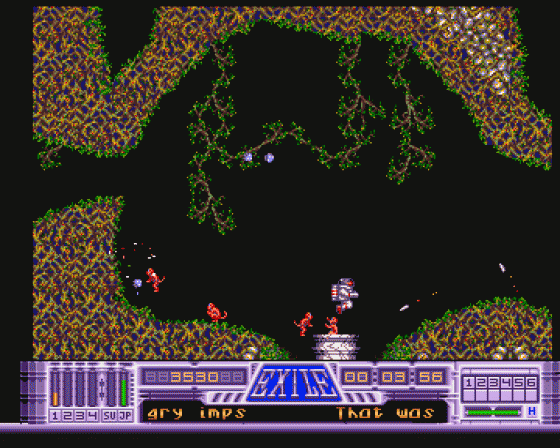
So as you'd expect, Exile has a sizeable map to explore, packed with generous helpings of action and a goodly number of objects to collect and use. Nothing wrong with that, but it's all fairly unremarkable - what makes Exile so dreamy is the way in which it so successfully mimics the real world while artfully missing out all the dreary bits. Step away from it a second and look at it from another angle - where before have you been able to interact so effectively with your environment? Not in another game, that's for sure. No, it may sound overblown, but in many ways Exile effectively acts as a simulation of everyday life on an Earth-like planet.
It's because everything in the game obeys the laws of physics to realistic effect. It's because every object has its own mass and so, when combined with the gravitational pull of the world, a host of swish inertial effects can be experienced by the player. It's because if you want - and I'd recommend it to anybody - you can forget about the big task in hand for a bit and immerse yourself in the simple challenge of trying to fly about the place holding a flask full of water in one hand without spilling a drop.
As you might have guessed from that last sentence (the word 'holding' was the giveaway) you don't control a ship or a robot in Exile, but a lone space soldier. This guy has to be one of the most versatile computer characters ever seen. Initially equipped with just his bare hands, a jetpack, and a protective suit with four 'pockets' (objects small enough to fit in these can be stored for later use), he can run, jump and fly in pretty much any direction. Not only that, he can duck, pick up and drop items, throw objects or shoot in a definable trajectory (which is especially handy when it comes to lobbing grenades) and all sorts of other stuff too.

Of course, despite my efforts to persuade you to the contrary, Exile isn't really a simulation at all, it's a game, and as such it contains certain chores that you must set out to complete. Your task is to rescue a handful of fellow space soldiers from where they're trapped by a mad professor deep within a vast network of underground caverns. The playing area is proportionally half a mile square, and the number of puzzles to solve is... well, it's difficult to quantify, as most of the problems come about through the unique way the objects interact with each other. Let's just say there are an awful (awful) lot.
Further emphasising that it's actually a game we're talking about here, points are awarded for every kill made and for performing certain tasks, though of course the pleasure gathered from making a discovery is the far greater incentive. It's almost as if the programmers are aware of the temptation Exile gives to abandon the job in hand and zoom off and explore in another direction for a bit - to ensure players keep on the move, and to instil a sense of urgency, a point is lost for every second which passes.
As you make your way around in Exile, you'll find there are three problems that keep coming up. Firstly, how do you keep your energy level high and how do you ensure you've got the right weapons for the job? Secondly, just how are you meant to interact with all the animals you keep encountering? And thirdly, just how are you meant to get about the place anyway? Let's deal with them all one at a time, shall we?
A Small Matter Of Energy
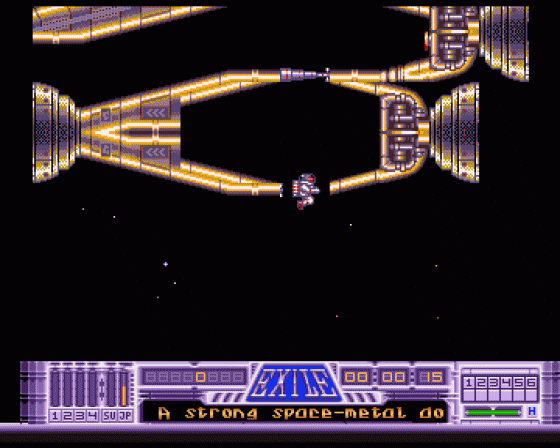
There's this to consider of course. Your jetpack needs it, as do your guns. Ah yes, the guns. The first of many weapons - you don't come equipped with any to start with, remember? - is found just beneath the surface. It's a low-powered handgun which is only really effective against the weakest of the planet's inhabitants. Deeper into the caverns there's a second, more powerful handgun waiting to be discovered, along with two meaty (but energy-hungry) blasters. Watch for the recoil though - it's a little on the strong side. (We are talking about a game where you realistically interact with your environment, after all). Meanwhile, back on the surface, a powerful cannon sits inside the wreckage of a ship. The only problem is, just how do you bring it out into the open?
So with all those options you should be alright gun-wise. What you need now is the power to run them on, and fortunately (though the use of energy is realistic in the game, and you do need to keep topping it up) it's never too inhibitive. There are normally plenty of booster packs to be found, and if the worst comes to the worst you can always transfer energy from one device you're carrying to another.
Talking To The Animals
Here's something else to consider - the inhabitants of Exile's world. These have varying degrees of intelligence and spend most of the time going about their own business. Some creatures are scared of newcomers and so attack almost immediately - certain breeds of bird for example - while others tend to keep themselves to themselves until they are interfered with. Don't worry about the killer bees too much, for instance - they'll only go for you if you threaten them (if you start shooting at their hive, for instance). More fearsome are some of the creatures you'll come across in the pools and lakes you discover deeper into the adventure - crabs, giant clams and piranha fish.
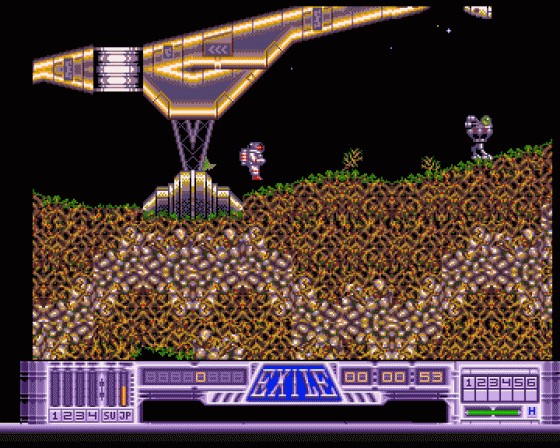
One set of creatures you should be especially wary of are the imps. Try picking up a frog or similar and giving it to them - these mischievous monkey-like beings have pouches in which they carry stolen items. I came across a handy stick-like torch and power replenishment packs, and with a bit of persuasion got them to give them to me. Be careful though - they *are* mischievous, and take great delight in throwing things at you, which can be problematic. (The spores from the mushrooms will temporarily block your jetpack, for instance.)
Potentially most helpful of all the creatures encountered is Fluffy - a sickeningly cute ball of fluff (no surprises there) who has a tendency to squeak uncontrolably when loud noises such as gunfire disturb him from his usual happy state of eating. He becomes your sort of side-kick with very little persuasion, and can prove very useful indeed - his speciality is squeezing through gaps smaller than you can handle.
Not quite animals, but near enough to warrant inclusion here, are the mobile robot types you occasionally have to contend with. One, called Chatter (and it soon becomes pretty obvious where he got his name from) is actually friendly, and can prove as useful as Fluffy. Feed him with a certain type of crystal (either found lying around or converted by burning mushrooms) and he'll be on your side - one of two whistles can then be used to control Chatter and get him to help you out.
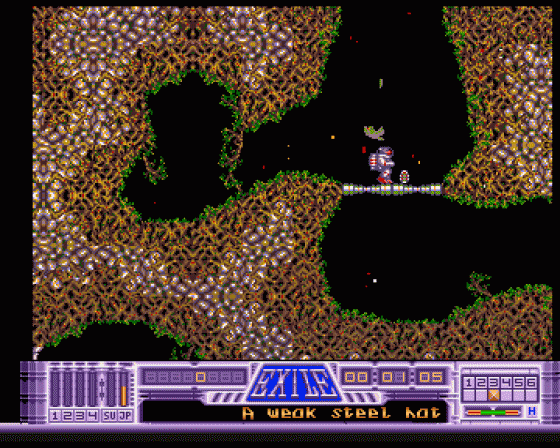
(Incidental note: The imps were in fact monkeys at one point, which explains the way they act, I guess. They were changed after the Japanese saw Exile and went sparky - not surprising when you realise monkeys are in fact sacred in Japan.)
The Safer Way To Travel
Getting from A to B in such a vast playfield can prove time and energy consuming - and tiring too. That's why the smart hero about town gets around via the many teleporters dotted throughout the caverns. Your good self is not the only thing capable of being teleported. Anything goes: objects, robots, creatures - even bullets. The only problem is, most of the teleporters can only be turned on and off if you are in possession of the relevant pass.
A limited form of teleportation is also built into your suit. It's more of a simplistic save of sorts really, with the facility to sore the coordinates of four 'destinations'. This feature has more than one use than is at first apparent. For a start, you don't actually die in Exile - instead you are teleported back to the last teleport position remembered, or to the default position of your ship orbiting above the planet. Better still, the personal teleportation can be used to pass pushy aliens. By remembering your position before allowing yourself to be pushed away, you can teleport behind the being and continue.

Fortunately, there's also a more fullsome save function - either quickly to RAM or more permanently to floppy disk.
Exile's great strength lies in the fact that you can do pretty much anything you would do in an equivalent real life situation. The lighter the object, the better it floats and the further it can be thrown. Objects or creatures which look as though they should burn do. How should you best go about exploring the underground lakes, for instance? Simple - carry an object heavy enough to make you sink!
Everything seems real, everything works, and this attention to detail seems to be present on almost every level. Sonically, it's impressive too - objects make an audible splash when they hit water, and every creature and almost all events have distinctive soounds, with the volume varying depending on the distance between you and the noise. You can hear the bees buzz, the birds squawk, and so on.

The problems you're faced with turn out to be pleasingly logical too. Whether simple mechanical teasers (how to get past the thick sliding doors, say) or slightly more complicated biological ones (how to cope with the poisonous mushrooms) the answers actually make sense, rather than seeming arbitrarily placed there.
Exile even has educational potential. Learning with textbooks can be dull at the best of times, but with a model such as this you can actually go around and do things for yourself - introduce chemical x to chemical y for instance, and witness the reaction - and learn through enjoyment. Exile promotes experimentation without having to deal with a ho-hum series of windows or pull-down menus.
But pretentious possibilities aside, Exile is a bit tasty and no mistake. It's entertaining, highly rewarding and so involved that you won't get through it in a hurry. Apparently, it takes the authors about six hours to play from beginning to end - and they know it inside out.
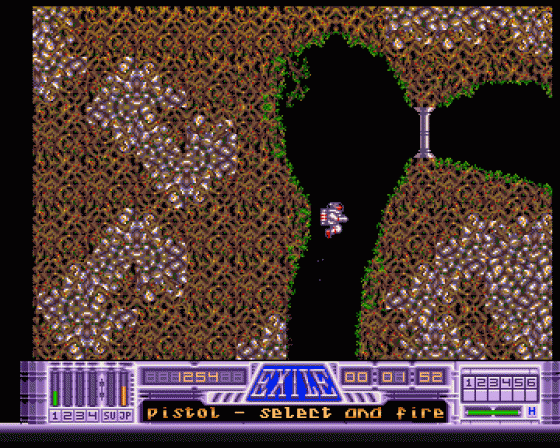
So where does that leave us? Well, with a new sort of arcade adventure - better than the last one, and opening hundreds of possibilities for the future. The arcade adventure is dead. Long live Exile.
Verdict
Uppers: A massive playing area, packed with things to discover and do, smashing sound effects and a glorious control mode. What makes Exile really special though is the way 'real world' physics and realistic creature behaviour have been implemented.
Downers: Well, let's face it, it's no oil painting. Occasionally, you may find it's not always all that easy to figure out what to do.

The Bottom Line: Beyond being simply a very good game, Exile represents the future of arcade adventures. There's nothing quite like it available, though if there's any justice, there'll be loads in the years to come.
The Men In Exile
So who are those three names behind Exile? Surprisingly, between them they have had little commercial success. Jeremy Smith wrote Firebird's Thrust (an 'official' tribute to which appeared as Zarathrusta from the late Hewson recently), but Peter Irvin on the other hand - well, he's only ever written an ancient (but rather corky) shoot-'em-up called Starship Command for the BBC.
The long-standing Irvin/Smith friendship flourished into a partnership when they decided to write a game from scratch. From this, Exile originated on the BBC and was converted to the Commodore 64. William Reeve then reproduced the C64 version on the Amiga before Peter rewrote it to take fuller advantage of the new machine.
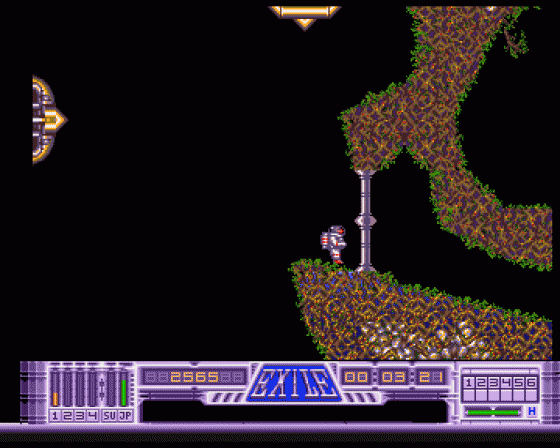
Exile has taken a year to reproduce and enhance on the Amiga, partly because Peter had to learn about the Amiga from scratch, but also because "You lose inspiration after a while. After about six months or so, it all starts to slow down."
It didn't help that the ideas behind Exile weren't particularly clearly thought out at first, either.
"It started off basically with just the concept of some spaceman flying around and having collisions with real forces and creatures bouncing off each other," Peter reveals. "We designed the game around it from there. It evolved very slowly - only later did we realise it should be totally modelled on real life. It's one of those games which, having written it, if you were to write it again you could do it an awful lot faster."
On The Other Hand
Hmm. I don't know quite where to start really. This reminds me of an old Commodore 64 game. The control and layout feels a lot like Thrust, it's very cute and appealing in places, it's very bid and it has a nice feel to it.
Don't get me wrong - I like the game. But the future of arcade adventures? An educational tool? Come on. I can't for the life of me see quite why Gary's gone so overboard about it and am desperate for him to really sit down and explain it to me. I'm coming at this with an open mind, I'm willing to be persuaded, but on a first look (and from the admittedly fairly small amount of playing time I've given it) I can't quite see what all the fuss is about. It's good, it's fun, but for my money it's not really worth much more than 80%.
Matt Bielby
Other Reviews Of Exile For The Amiga 500
Exile (Audiogenic)
Having always been a bit of an exile from society (as his Borstal and Broadmoor records confirm), David 'McVicca' McCandless decided that this game suited him down to the ground (and anyone who argued could discuss it with his Foster & Furnace RX27 Thermo-Cannon).
Exile (Audiogenic)
A review by Paul Rand (C&VG)
The Amiga Power All-Time Top 100 '92 Part 10
Special Souvenir Supplement
Exile (Audiogenic)
A review by Cam Winstanley (Amiga Power)














